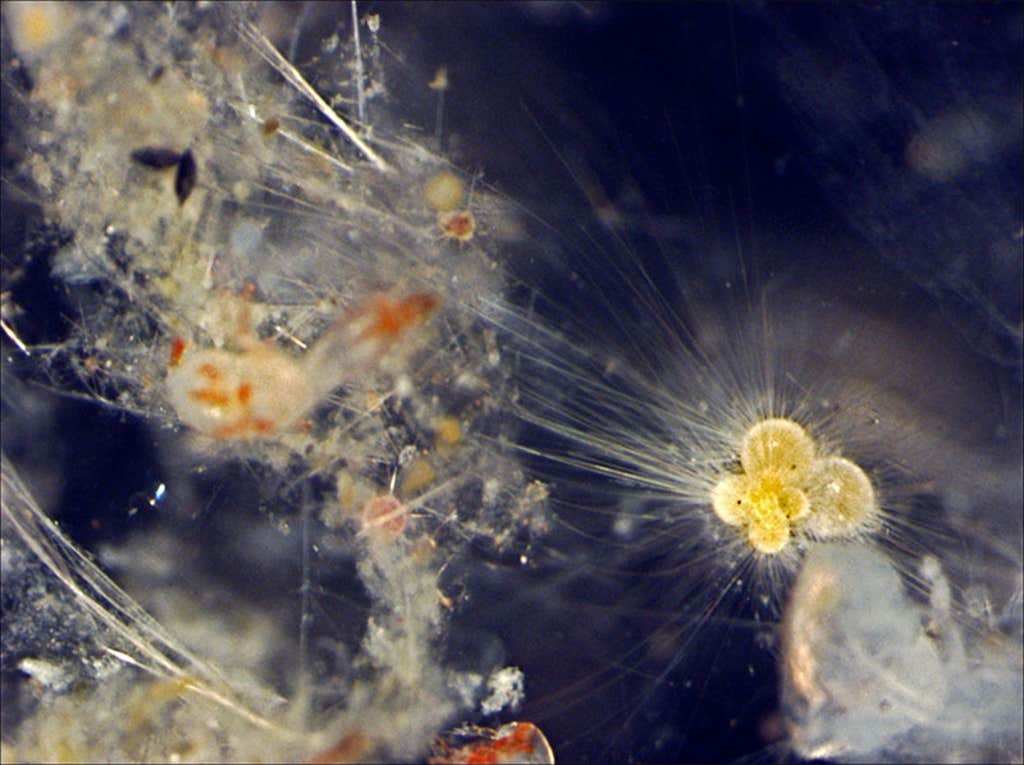This article originally appeared in Knowable Magazine.
Climate change and declining biodiversity are the two biggest environmental crises facing humankind today, but predicting how they’ll play out together is tricky. Ideally, scientists would study how life on Earth responded to previous periods of drastic climate change, but the fossil record for most species is spotty.
The fossils of foraminifera are an exception, however: They’re everywhere.
These unicellular marine organisms are encased in shells often built from calcium carbonate, the main ingredient in chalk. Their name, derived from Latin, refers to the holes connecting the different chambers inside their often-beautiful shells. A fringe of extensions protruding around the shell allows them to find and collect food.
“When you look at a living foram, it’s like a little grain of sand with a big sunburst of snotty tentacles around it,” says paleoceanographer Chris Lowery of the University of Texas at Austin.
Most foraminiferan species reside on the seafloor, but paleontologists are particularly interested in planktonic species, which live suspended in open water. Because of their astonishing numbers and short lives, their fossils are found globally across the ocean floor.
This has allowed researchers to reconstruct in detail which species flourished and which suffered when climate changed in the past, all by studying the shells and the chemical clues they contain. “If you do a little bit of chemistry on a foram shell, you can reconstruct things like the water temperature when it was growing,” says micropaleontologist Andy Fraass of the University of Victoria in Canada. “So they can tell us a lot about oceanic conditions.”
“We jokingly refer to the Oligocene as the Uglyocene.”
Researchers study the fossils by drilling into ocean sediment to reveal layer upon layer of the calcareous shells. The deeper they go, the further they look back in time. “You can pull up a tube of mud from the ocean floor, and take samples along its length, and they’ll each contain thousands of forams: a detailed record of their local history,” Lowery says.
This kind of work has helped to reveal that planktonic foraminifera first showed up in the Jurassic period about 180 million years ago but experienced a major crisis when an asteroid hit the Earth some 66 million years ago. “Everyone talks about the dinosaurs going extinct at that time,” says micropaleontologist Paul Pearson of University College London, “but we know the details of what happened from foram fossils. First, there are many, then a distinct layer formed right after the impact, and [then there are] very few after.”
The impact vaporized rocks, releasing large quantities of sulfur and dust into the air. “That, and smoke from the many fires, blocked out sunlight for years,” says Lowery, who was part of an ocean-drilling expedition in 2016 investigating the crater left by the asteroid. “This prevented the algae at the base of the marine food chain from doing photosynthesis and caused many ecosystems to collapse.” Deep-seafloor-dwelling foraminifera, which were far away from the surface and were able to keep feeding on the remains of dead organisms, were mostly fine, but nine out of 10 planktonic species went extinct.

After this mass extinction, it took about 10 million years for foraminiferan species diversity to recover, Fraass and Lowery reported in 2019. “When species go extinct, it’s as if a big branch of their family tree breaks off,” says Fraass. “And it takes a lot of time to re-evolve enough diversity to regrow a branch.”
Yet for those that survived the carnage, this created opportunities. “With so many species gone, there is less competition for previously rare resources, and even unusual individuals may have a shot, and perhaps be surprisingly successful,” says marine ecologist Tracy Aze of the University of Plymouth in the United Kingdom.
Soon after the impact, a new type of foraminiferan appeared, says Pearson, “studded with spines that may have helped them to float as well as capture more food.”
While the asteroid’s sun-blocking fallout caused a period of severe cooling, the next big crisis sounds eerily more familiar: About 56 million years ago, the average temperature on the planet increased by up to 5 degrees Celsius, possibly due to greenhouse gas emissions from volcanic activity.
It’s like a little grain of sand with a big sunburst of snotty tentacles around it.
Seafloor foraminifera in deep waters were badly hit, likely because high levels of CO2 entering the ocean caused acidification that damaged their calcareous shells—such effects are the greatest at large depths. But this time, few plankton species went extinct, in part because foraminifera escaped the warmth by moving to colder areas.
“In the tropics, it may have become too hot for them to survive, with water temperatures up to 40 degrees Celsius,” Aze says. “But we see many tropical species show up in more temperate areas—while temperate species shifted polewards, as they are again doing today.” Many foraminifera found refuge in or near the Southern Ocean around Antarctica.
Another mass extinction started around 33.9 million years ago, caused by a big dip in temperatures in a period called the Eocene-Oligocene transition. This foreshadowed a gradual cooling that would culminate in the most recent ice age. “We jokingly refer to the Oligocene as the Uglyocene,” says Aze. All the weird and wonderful planktonic foraminifera disappeared, and only some small unornamented ones remained. “We’re not sure why.”
As before, that big crisis created big opportunities, and new species evolved with new habits and habitats. Currents originating at the poles caused increasing temperature differences between ocean layers that peaked near the equator. This created a wider range of conditions that supported a rich variety of species.
In a 2023 study, Aze and others showed that around 15 million years ago, the global spread of foraminiferan diversity became roughly what it is now—greatest near the equator and gradually decreasing toward the poles.
What do these past events tell us about what we might expect for foraminiferan diversity—and that of other species—on a planet we are rapidly warming up today?
In a 2023 study, Pearson and colleagues used foraminifera fossil data to predict the fate of the ocean’s twilight zone, a region 650 to 3,300 feet below the surface. They estimated that the food supply reaching the middle of this zone will decline more than 20 percent in a mild warming scenario in which the average global surface temperature rise stays below 2 degrees Celsius, and decline up to 70 percent in the unlikely event that temperatures rise 6 degrees by 2100. That’s because warming increases the rate of decay of falling organic debris, so that less of it reaches the twilight zone.
This would likely wreak havoc in this vast but understudied part of the world that provides crucial habitat to many marine animals that dive for prey as well as to unique species like lanternfish that descend there during the day.
Already, says Aze, organisms are shifting their ranges poleward in response to global warming and, in step, scientists have noted a dip in diversity of foraminifera around the equator. “That will likely expand,” she says.
Though some species may find temporary refuge by moving toward the poles, the pace of climate change may be too rapid for many. A 2024 study of foraminifera trends found that foraminiferan abundance has declined almost 25 percent over the past 80 years.
That might be a bad sign for biodiversity in other groups of creatures, which often follow foraminiferan trends. Since foraminifera as a group bounced back from several mass extinctions, they are very unlikely to disappear, says Fraass. But recovery may take a long time, and humanity’s involvement makes predicting the near future especially difficult. Or as Lowery put it: “Ask me again in a couple thousand years.” ![]()
Lead image: These fossilized foraminiferan shells, dating back 35 to 45 million years, were found in Tanzania. They all belong to species that are now extinct. The largest are about half a millimeter in diameter. Credit: Paul Pearson / University College London.





























